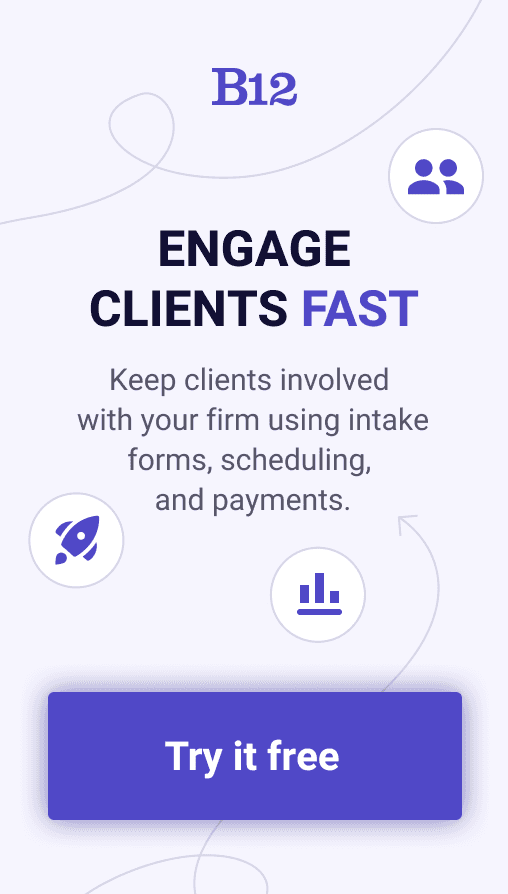Build an AI website in 60 seconds
AI generates your personalized website instantly with built-in scheduling, payments, email marketing, and more.
Start for free
Should you use sticky menu navigation on your website?

TL;DR - The Pros and Cons of Using Sticky Menu Navigation
- Sticky menus keep navigation visible as users scroll, improving access and engagement.
- Benefits: faster navigation, better aesthetics, promotes key content, longer site visits.
- Drawbacks: potential distraction, slower load times, implementation challenges.
- Best for: long pages, complex sites, or pages with important CTAs.
- Test, optimize, and implement carefully for best results.
If visitors can't navigate your website intuitively and find what they're looking for in seconds, they'll abandon it. Sticky menu navigation is a popular style because it allows users to access the content they need quickly.
Looking to improve your website's navigation menu and increase on-site time? In this article, we'll cover the advantages and disadvantages of sticky menus and offer guidance on when and how to utilize them for the optimal user experience.
What is a sticky menu on a website?
Sticky menu navigation is an increasingly popular trend in web design. It keeps a menu bar at the top of the page visible on the screen while the user scrolls down. This menu bar design makes using menu items easier for visitors by preventing them from having to scroll back up to the top of the page.
Although websites on desktops are the likeliest place to find this kind of navigation, mobile browsers are also starting to use it more frequently. The popularity of mobile devices has led to a surge in this kind of navigation. As users scroll through pages on their phones, they may only be able to easily access the menus needing to scroll back up to the top. Sticky headers allow users to access the menus without doing this. It also allows users to access the menu items quickly, saving time and providing a more efficient user experience.
A sticky header can also create a more aesthetically pleasing experience for users. The website can maintain a consistent and unified design by keeping the menu items visible. This can be especially useful for long-form content, as the menu items can remain visible throughout the page, giving the user a sense of continuity.
Moreover, sticky menu navigation can promote important content or features. Users can easily access the content or feature the site wishes to promote by keeping the menu items visible. This sticky menu can be especially useful for websites that contain a large amount of content, as the most important content will be easily accessible to users.
Benefits of using sticky menus on your site
A sticky widget navigation is an important tool for creating a great user experience for website visitors. It helps them to quickly and easily navigate through the website content. A fixed navigation menu can be fixed to the top or bottom of the page and is often seen as a persistent navigation bar or menu. Several websites, like WordPress, employ this style of navigation extensively since it works well at assisting users in finding what they're searching for quickly.
One of the main benefits of using a sticky elements menu is that it helps visitors quickly access the content they seek. Users may obtain the material they require without always having to scroll to the top of the page by having the sticky navigation menu permanently displayed.
Visitors won't waste time scrolling back up to the top of the page, making website navigation simpler and more effective.
Sticky navigation features also help to keep visitors on the site for longer. Users can quickly jump from one page to another and explore the different content by always having the navigation bar visible. Given how simple it is to browse between pages, this encourages users to stay on the website for longer. The overall user experience and engagement with the website may thus be enhanced as a consequence.
Another benefit of a fixed navigation bar is that it helps improve the entire site's aesthetics. Having the sticky header always visible makes the website more organized and professional. This can create a better user experience and make the website more appealing to visitors.
Disadvantages of sticky menu navigation for user scrolls
Sticky menu navigation is a website design technique that gives users easy access to navigation controls at all times, regardless of scrolling. While this type of navigation can provide a great user experience, it has drawbacks. Understanding the potential drawbacks of sticky menu navigation before implementing it on your website is important.
One drawback of the sticky navbar can be increased page loading time. The menu remains on the page builders, even if the user has scrolled down. This means that the menu’s HTML and CSS must be loaded every time the page is loaded, resulting in slower page loads. Sticky menus can increase the amount of data that needs to be transferred since the menu needs to be downloaded every time the page is loaded.
Another disadvantage of sticky menu navigation is that it can distract users. This is because the menu is always visible, even when unnecessary. This can lead to users getting distracted by the menu and not focusing on the page's content. Additionally, the sticky element can take up valuable screen real estate, which can be used for other elements.
Sticky menu navigation can be difficult to implement correctly. This is because the sticky element needs to be responsive to work correctly on all devices. Moreover, it must be applied to prevent obstructing other page components. This can be challenging to do and demands meticulous attention to detail.
Overall, it’s necessary to understand the potential drawbacks of sticky menus before implementing them on your website. While it might offer a fantastic user experience, it can also have some detrimental effects, such as longer page loads, distractions, and implementation challenges.
When to use sticky headers
When to use sticky menu navigation on a website can be a difficult decision. This type of navigation is relatively new, and some websites have better choices. In general, websites with lengthy content pages or where customers must scroll through a lot of material to discover what they're searching for are best suited for sticky menu navigation. It's also a great way to keep important navigation elements visible, so users can quickly and easily navigate different website pages.
Sticky navigation is especially useful for sites with multiple levels of navigation. A great example is online store sites.To reach deeper levels, users don't need to scroll back up the page. Sticky menu navigation is also a great choice for sites with lots of content across multiple pages. Users may quickly move between pages without having to scroll back to the top by keeping the menu displayed. This may be especially helpful for websites that have lengthy text pages because it makes it much simpler for users to rapidly flip between subjects.
Sticky menu navigation can also draw attention to important features or items on a website. Users are more likely to see the items or features you want them to notice by having the menu always displayed. For websites that largely rely on calls to action or seek to showcase a certain good or service, this may be extremely helpful.
How to implement a website sticky header
The first step in implementing sticky menu navigation is to decide which navigation menu elements should be included in the sticky version. Generally, the most vital elements, such as the logo, home page link, and any major categories or pages, should be included. The next step is to create a sticky menu display with the HTML and CSS code. This code must be inserted into the website's existing HTML code.
Once the HTML and CSS code is written, the sticky navigation can be tested in different web browsers. It's crucial to guarantee that the navigation functions properly across all browsers and displays consistently on all devices. Prior to the code being placed on the live website, any navigational concerns should be fixed.
Following this, the sticky header should be optimized for performance. This can involve minifying the HTML and CSS code, reducing the size of images, and using caching and other performance optimization techniques. These steps will help ensure the website's sticky header loads quickly and effectively.
Implementing sticky menus is a straightforward process that can have a big impact on the user experience of your website. With the right code and optimization techniques, you can ensure the sticky header works well and looks great on all devices.
Optimize your web design using B12's AI website builder
Overall, sticky menus can greatly improve user experience and engagement on your website, but it's vital to think about when and how to utilize it. A sticky navigation menu can be a great asset for your website if implemented correctly. Working with professional web designers, like the ones at B12, ensures that your site gives visitors quick access to important information about your firm and services without adding clutter, confusion, or load time.
Need a professional online presence for your business? Try B12 today to get a website built by AI and refined by expert designers, copywriters, and SEO specialists. Make DIY changes any time you want. See your website draft instantly for free, with plans that also let you launch for free.
FAQs
What is a sticky menu or sticky header on a website?
It’s a navigation bar that stays visible at the top (or bottom) of the screen as users scroll, providing continuous access to key links without needing to scroll back up.
How does sticky menu navigation work on desktop versus mobile browsers?
On desktops, sticky menus typically span the top of the page, remaining fixed as the user scrolls. On mobile, they’re often smaller or collapsible to save space while still keeping key links accessible at all times.
Does a sticky menu slow down page‑load speed?
A sticky menu can slightly slow down the website if not optimized because it requires additional CSS and JavaScript. B12 uses best practices to ensure sticky menus load quickly and efficiently while keeping navigation accessible at all times.
Which types of sites or pages (e.g., long‑form content or online stores) benefit most from sticky headers?
Sites with long-form articles, online stores, and content-heavy pages benefit most. Sticky headers keep navigation and actions visible, improving user experience. B12 seamlessly integrates this feature into designs for such websites.
Can a sticky header increase user engagement and on‑site time?
Yes, sticky headers make it easier for visitors to explore more pages and interact with the site. B12’s designs help you use this feature to keep users engaged and improve overall website performance.
Attract, win, and serve more clients
Receive helpful resources directly to your inbox to help you succeed online.
Draft your site in 60 seconds
Get an AI website made specifically for you that's free to launch.
Start for free ✨No credit card required
Spend less time on your website and more time growing your business
Let B12 set up your professional online presence with everything you need to attract, win, and serve clients.





